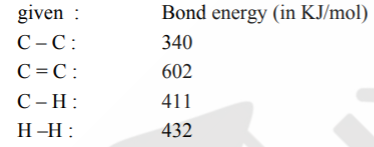Calculate ΔhHɵ for the addition of 1 mol of H2 to (i) benzene (C6H6) and (ii) 1,3-cyclohexadiene (C6H8) from frigure.
Strategy (i): Target is to find ΔhHɵ of the following reaction benzene +H2→1,3−Cyclohexadiene
Thus, look for the data involving these two compound.
strategy (ii). We need to find ΔhHɵ of the following reaction:
1,3−C6H8+H2→C6H12
Thus, we look for the data involving these two compounds.
Text Solution
(a). C6H6+3H2→C6H12, ΔhHɵ=−208Kgmol−1
(b). 1.3−C6H6+2H2→C6H12, ΔhHɵ=−232kJmol−1
Substracting second equation (b) from the first (a), we get
C6H6+H2→1,3−C6H6, ΔhHɵ24kJmol−1
(ii). (a). 1,3−C6H6+2H2→C6H12→C6H12, ΔhHɵ−232mol−1
(b). C6H10+H2→C6H12, ΔhHɵ−120kJmol−1
Subtracting second equation (b) from the first (a), we get
1,3−C6H8+H2→C6H10, ΔhHɵ112kJmol−1
|
Topper's Solved these Questions
- AROMATIC HYDROCARBONSBOOK - R SHARMACHAPTER - AROMATIC HYDROCARBONSEXERCISE - Follow up Test 1
10 Videos
- AROMATIC HYDROCARBONSBOOK - R SHARMACHAPTER - AROMATIC HYDROCARBONSEXERCISE - Follow up Test 2
13 Videos
- ALKYNESBOOK - R SHARMACHAPTER - ALKYNESEXERCISE - Archives
42 Videos
- CHEMICAL BONDINGBOOK - R SHARMACHAPTER - CHEMICAL BONDINGEXERCISE - Archives
73 Videos
Similar Questions
Knowledge Check
The reaction represents :
C12H26→C6H12+C6H14ASubstitutionBSynthesisCCrackingDPolymerizationThe reaction represents :
C12H26→C6H12+C6H14ASubstitutionBSynthesisCCrackingDPolymerizationIf ΔfH∘(C2H4) and ΔfH∘(C2H6) are x1 and x2 K cal/mol, then heat of hydrogenation of C2H4 is
Ax1+x2Bx1−x2Cx2−x1Dx1+2x2
Calculate the DU of following compounds :
(i) C6H6ClBrO , (ii) C5H9N
View SolutionCalculate the DU of following compounds :
(i) C6H6ClBrO , (ii) C5H9N
View SolutionFor the reaction C12H22O11+H2OH+−−→C6H12O6+C6H12O6, write
(i) Rate of reaction expression (ii) rate law equation (iii) molecularity (iv) order of reaction
View SolutionFor the reaction:
C12H22O11+H2OH+−−→C6H12O6+C6H12O6
write:
(i) rate of reaction expression.
(ii) rate law equation.
(iii) molecularity.
(iv) order of reaction.
View SolutionIf ΔfH∘(C2H4) and ΔfH∘(C2H6) are x1 and x2 kcal mol−1, then heat of hydrogenation of C2H4 is :
View Solution

